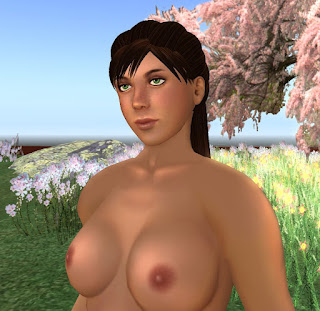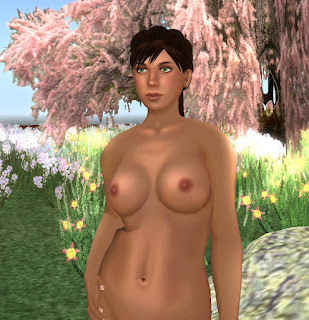So far we've just been taking the shortest path to producing a skin with Eloh Eliot's Open Source Skins. Next we will explore some of the options Eloh has provided for us, and then dip our toe into making modifications of the skins she has provided.
But first!! ....
We need to talk about an important, though quite technical, issue. Its that of file size. To paraphrase the famous quote from Albert Einstein, we need
to make everything as small as possible, but no smaller. This translates into doing two things BEFORE we upload our files into Second Life:
- Scale the files from 1024x1024 to 512x512. (smaller would be too small)
- Make the file type JPEG (jpg) on the files that have no transparency (upper and lower) and PNG (png) on the file that does have transparency (face). In this application I've seen the jpg files be 1/10th of the size of the same thing saved as a PNG file. So reserve the PNG file for cases where you need it, for example the face file.
I hadn't mentioned this technical issue before to keep things simple. But as we near the point where we will be moving from temporary files to permanent files, its important to keep the size of the files we're creating in mind. Scaling the files is very easy in GIMP, here's what you do:
- First save the file in its 1024x1024 size. you dont want to loose it. Do this with File->Save.
- Use Image->Scale Image. Simply type 512 on the Width and press enter, the Height will change for you. Then click OK and watch GIMP make the file smaller.
- Use File->Save As. I change the file name to add '...512.jpg' or '...512.png' to the end as a reminder that i have made the file smaller. So an example name might be "starlight_face yymmdd 512.png" and "starlight_upper yymmdd 512.jpg".
Modifications:
Now on to the fun stuff - modifications. This is where you start to personalize the files to something that YOU like.
As you were looking through the layers you might have noticed that there were layers that were not visible and they had names like breastB or lipsA. We will make use of just one of these,
changing from lipsB to lipsA and look at the difference it makes to the shape. And we will be just a little more daring - and
modify the basic skin color so something a shade or two darker.
Modifying the lips:
Ok, here's what to do: Open up the "starlight_face 110228.xcf" file we created before and look through the layers and find those that start with lipsA. Most will have a little eye next to them indicating that they're active. Go through and click the eyes turning them all off. Now if you look at the layers below, you will find a bunch named lipA. You'll need to turn MOST of these layers on, but NOT ALL. For now, turn on all EXCEPT:
- lipsA.base
- lipsA.base.lighter
- lipsA.color.* (leave all of the lipsA.color layers off for now)
That should make 18 lipsB layers turned off and 18 lipsA layers turned on.
Now look at the image shown by GIMP.... to my eyes the shading at the corners of the mouth and below the lower lip look a bit dark. So we will adjust them. For the corners, find lipsA.corners.shade and drop the opacity from 100 to about 20. For the shade under the lower lip, find lipsA.lower.shade 2 and turn it off (click the eye to turn it off).
 Modify the skin color:
Modify the skin color:
Now its time to be brave and modify the skin color. :)
In the layers window, scroll all the way to the bottom. You'll see a layer named 'base.color'. Select it by clicking it (the line will have a blue back-light) and find the 'duplicate layer' button (circled in the image on the right) and click it. You will get a new layer above the selected 'base.color' named 'base.color copy'. (Click on the picture for a closer look.... and if your cursor shows a plus sign in it as you hover over the image, click again for an even larger view)
Now select that layer and choose the "color picker tool" from the GIMP Toolbox Window. (For reasons that are not clear to me, it looks something like an eyedropper.) Now go to the image window and click on it with that 'color picker' and you should see the "foreground color" in the Toolbox window change to be that of the 'base.color copy' in the image window.
Next we will click on that "foreground color" in the Toolbox window and you will see a window open to help you change the color. It should look rather like the image below this paragraph.
We will pause here for a minute and look at the Change Color window. Note the series of six rows to the right labeled, H, S, V, R, G, B. These are the color change controls and they are two groups, HSV and RGB. HSV stands for Hue, Saturation and Value and RGB stands for Red, Green and Blue. Both are complete - you can use just one set or the other. For some purposes HSV is easier to use and for other purposes RGB is easier to use. I'll let you google the two for more detailed information, for our purposes here we'll be using HSV. In fact, for the present, we'll just make some small changes to the Saturation and Value leaving the Hue alone.
If you look at the large color window on the left of the image above, you'll see what looks like a cross-hair inside it. Now draw a diagonal through that cross-hair sloping down from left to right. We will want to work along that line for the skins. Its probably not a straight line though. I would expect it to be curved away from the extremes at both corners so something more like the red line drawn in the picture to the right would be the right range of reasonable colors for skins.
We want to make the color of the skin a little darker. That means we will want to move that cross-hair up and to the left a little. If you play with the S and V values with the controls (circled on the right in the image) you'll find that changing the S value will move the horizontal part of the cross-hair up and down, and changing the V value will move the vertical part of the cross-hair left and right. So.... moving the cross-hair intersection up and to the right will mean INCREASING the S value and DECREASING the V value. For now... I would suggest increasing S by 3 and decreasing V by 4 so the final values will be 54 and 60.
Now we want to apply this new color to our copy of the base color layer we created earlier. So - make sure that the "base.color copy" layer is selected in the layers window, and choose the "Bucket Fill Tool" in the Tools window (it looks like a tipping paint can) then make use of that tool on that layer by clicking on the image window. You should see GIMP make the change and notice that it the color is slightly darker than it was before.
Saving the File:
It's time to save our work. First we'll save the file as is, but change the name so we can backtrack if necessary. Then we'll scale the file to something smaller and save as a png file (we have some transparency in this file so we need to use png).
- File->Save As ... naming the file "starlight_face 110315.xcf" (the general format of the date is yymmdd in my scheme of things)
- Image->Scale .... choosing 512x512 and clicking ok.
- File->Save As ... naming the file "starlight_face 110315 512.png" (adding 512 to the name is a reminder that the image was scaled down, if you don't need it's ok to leave it off - but I DO need it).
Changing the skin color on upper and lower:
Making the same changes to the upper and lower textures for our new skin is pretty straighforward now that we have the color defined. I'll just list the steps for the upper, I'm sure you can work it out from that:
- Load "starlight_upper 110224.xcf" into GIMP.
- Go to the bottom of the layers window, select base.color and click the 'duplicate' button.
- Select the new layer named 'base.color copy' in the layer window
- Select the bucket fill tool in the Toolbox window
- Click in the image window and watch the new color be applied. (we're using the same color as we did earlier for the face texture)
- Save the file, changing the name as described above
- Scale the image as described above
- Save the file as a jpg image as described above.
Then repeat the above for the starlight lower file. (all of this takes longer to read than it does to do )
 Upload and try it out:
Upload and try it out:
Now go back to the previous blog post and repeat the process to upload the textures and apply them to a new skin. Remember to copy your current skin and name is with today's date so you can discard it and back up to the previous without running into problems.
After uploading the new textures and creating the new skin we should pause and look the results. As I mentioned in the previous post, we are now wading cautiously into the subjective so it's totally ok if your opinion of the changes made are different than mine.
Looking at the lips now, I like them better. They're still 'not quite right' but in my opinion, they're much more right than they were before. In the previous post I noted five things that were in the 'not quite right' category and I'll repeat them here:
- hand size
- leg length
- face length
- shoulder width
- lips
We'll make changes to each. But that will be the next post. *grins*
See ya!
Robin














